Ferrari boss Mattia Binotto explains five-year journey back to top end of F1


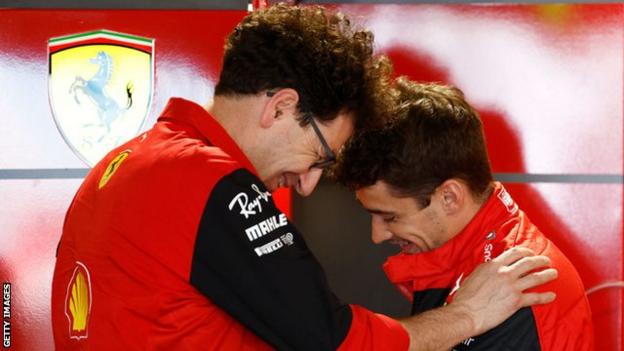
It’s taken half a decade and a pandemic for it to happen, but Ferrari are finally back at the top of Formula 1.
The ride along the way has been bumpy – with the jettisoning of a four-time champion, a brush with the regulations, the team sinking to a 40-year low, and a rule change.
After all that, though, Ferrari this year have the fastest car in the field – at least in Charles Leclerc’s hands and over one lap. And they are bona fide title contenders again, even if Red Bull and Max Verstappen look an increasingly tough challenge.
How have they done it? Team principal Mattia Binotto pauses to consider.
“It’s an interesting question but as well a difficult one,” he says, explaining that there is more to the transformation than just technical improvements. “The right reasons do not come [down] to the technical aspect, that we changed the [engine] combustion, [and] we improved our aerodynamics. That’s [only] the consequence.
“It is about building a team. The effort put in since 2017 has been step by step to build the right team. And with the right team, you can achieve the goals and targets. It’s all about the team.”
In an exclusive interview with BBC Sport, Binotto for the first time explains in detail the journey that has brought the sport’s most famous team back to competitiveness.
He discusses:
- Lessons from the collapse of Ferrari’s title challenges in 2017 and 2018
- The controversy over the legality of their engine in 2019
- How they bounced back from 2020, their worst season in 40 years
- Leclerc’s rise and growth
- Their 2022 title challenge
The painful lessons of failure
The story of Ferrari’s return to title contention starts five years ago, when they were last in a similar position.
Then as now, F1 was embarking on an era of new regulations. Then as now, Ferrari’s technical team aced the new rules, and their car brimmed with innovations.
Ferrari’s lead driver Sebastian Vettel led the 2017 championship for nearly two-thirds of the season, only to be overhauled by Mercedes and Lewis Hamilton in the final races.
The pattern repeated in 2018, when Vettel and Ferrari squandered a sizeable advantage with a series of team and driver errors and technical failures, without which they almost certainly would have been champions.
By the end of the season, the then-team boss Maurizio Arrivabene was unable to provide a convincing explanation as to what had gone wrong, and soon he was gone, replaced by Binotto.
Looking back, Binotto sees the problems clearly.
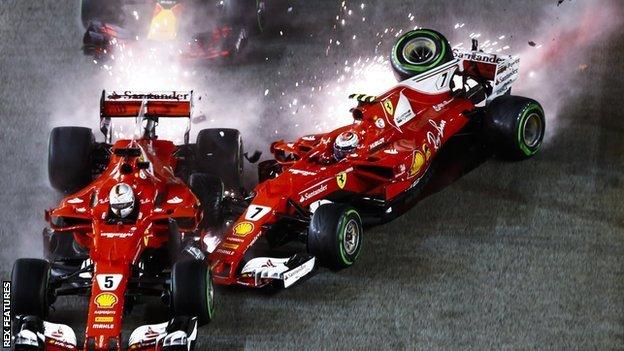
“As a team, we had already proved we had a good level of creativity and were capable of interpreting new rules,” he says, “and the car we made was a good one – the baseline, in terms of concept and idea. As a matter of fact, in the following years, the other teams copied our solutions.
“When I jumped into the role of team principal, I said it was a very young team. It was not that we were young in terms of age – I was 50 at the time. But we were young in our roles. We needed to build the experience.
“What we lacked in 2017, 2018 and 2019 [was that] we were not capable of developing the car.
“In 2017, we had reliability issues. We had our drivers crashing into each other, but we also had a team not strong enough in terms of culture and mentality. And on top of that, we didn’t have the right tools simply because we brought in developments that were not working as expected.
“We were good in terms of potential but green in terms of experience and tools.”
A rollercoaster ride in 2019
While Ferrari set about improving its facilities back in Maranello, another piece of the jigsaw was being addressed – the drivers.
At the end of 2018, the veteran Kimi Raikkonen was jettisoned after five unconvincing seasons and replaced by Leclerc, who had just one season with Sauber under his belt.
It was a move planned by Ferrari’s former chairman and chief executive Sergio Marchionne, whose restructure of the team had led to the production of their innovative 2017 and 2018 cars. Marchionne had his doubts about Vettel, and wanted to benchmark him against a driver who, though unproven, showed all the indications of being a future superstar.
Marchionne died unexpectedly in the summer of 2018, but his plan lived on. Leclerc proved an instant hit, putting the car on pole in Bahrain in only his second race for Ferrari, and losing a dominant victory only when his engine developed a problem in the closing stages.
In 2019, Binotto’s first year as team principal, Ferrari’s chassis was not as good as it had been in the previous two seasons, but an engine with prodigious power enabled Leclerc to take seven pole positions – and the team took six in a row at one stage.
But Ferrari’s rivals were suspicious. They felt Ferrari’s engine was too good, and after Red Bull secured clarifications from governing body the FIA on technicalities to do with fuel flow before the US Grand Prix that November, Ferrari’s run of poles dried up.
Then, over the winter of 2019-20, the FIA announced it had come to a private settlement with the team. It had “suspicions [the Ferrari engine was] not operating within the limits of the FIA regulations at all times”. Ferrari has always rejected this conclusion.
Binotto now says: “That’s in the past; I prefer not to talk about it any more. However, what we were doing at the time was pushing somehow the line of interpretations. As a matter of fact, it wasn’t illegal, or we would have been disqualified.”

A nadir in 2020
The engine controversy had a knock-on effect – on both engine and chassis.
“That way of exploiting the engine was powerful enough for us to have a significant disadvantage the following year that we were not expecting to have,” Binotto says.
“In that year, Ferrari was not the only one losing power on the grid. Most of the manufacturers lost power at that time. But we were the ones losing power the most and that put us from being at an advantage to a clear disadvantage.
“On top of that, we designed the 2020 car knowing we had a power unit advantage, so we designed it towards a lot of downforce, accepting a lot of drag.”
When the engine performance evaporated, Binotto says, Ferrari were left with “a car that was very slow on the straights”. He added: “The car was not properly designed in terms of targets, let’s say.”
Even worse, Ferrari had no means of changing it. Covid hit. F1 went into survival mode, and one of the emergency measures taken was to ban in-season development in 2020.
“We had no opportunity to improve the car during the season itself,” Binotto says. “It was a difficult moment, because I don’t think the fans understood it – or, generally speaking, the people looking at F1.”
The result was Ferrari’s least competitive season for 40 years. Leclerc produced the occasional miracle, such as qualifying fourth and finishing third at Silverstone, but overall, as Binotto puts it, “as a team, we suffered”.
Keeping the faith
In the past, a Ferrari team principal who presided over such a year could expect to lose his job, but the company kept faith with Binotto.
“At the time,” he says, “our CEO was Louis Camilleri and he had the vision to understand that what was most important was to give stability to the team. He understood that we had already started a process of building.”
This, Binotto admits, has amounted to a huge cultural change at Ferrari. Key to it is the adoption of a philosophy that has helped drive success at Mercedes over the past eight years – a “no-blame culture”.
“We worked a lot on that,” Binotto says. “It is taking the error more as an opportunity of a lesson learned, rather than blaming and pointing fingers.
“It is all about being brave enough to hear, to listen and to do something which is really open-minded. It is about working as a team, a single individual understanding the common responsibility.”
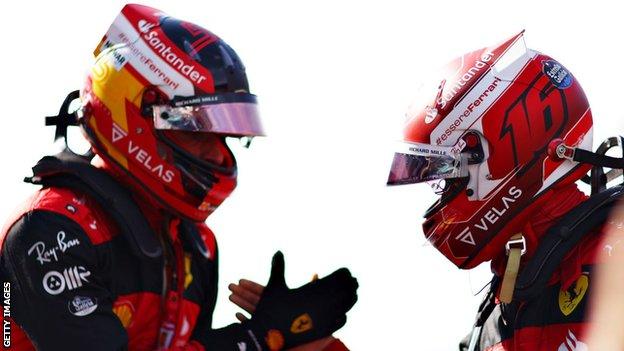
In 2019, Binotto combined the role of team principal with his previous one of technical director in charge of chassis and engine.
“But you cannot do well in both,” he says, adding that it took at least a year to restructure the team. “It’s only then we moved into an organisation where I was no longer technical director, but we have clear responsibilities.”
The head of chassis design, Enrico Cardile, is what in other teams would be called a technical director in all but name. Another Enrico, Gualtieri, took over Binotto’s former responsibilities on the power unit.
Cardile joined from Ferrari’s road car division in 2017. “He certainly did not have the skills specific to F1,” Binotto says. “But since then he has got five years on technical matters of F1, so is a lot stronger, and that’s the same for everyone in their proper role. Five years on, we have stronger skills and better people.”
But it has not been an entirely internal process. In the past three years, Binotto says, Ferrari “have employed more than 30 people from other teams, people who brought fresh ideas, new methodologies”.
“The team is people, culture, tools and methodology,” he says. “The car is simply the product of the team, starting in 2017 with a good base, but not with the right experience, skills and tools. Since then, step by step going through 2019, 2020, we have got to where we are today.”
A flying start to 2022
Originally, the new aerodynamic rules to which Ferrari have adapted so well this year were scheduled to be introduced in 2021, but they were delayed by a year as part of the series of changes F1 made in response to the pandemic.
Had the rules come in on schedule, Binotto does not believe Ferrari would have been so strong now. The delay “gave us more time to prepare ourselves, less distraction from the priority”.
First, they did so with the engine. Last year’s was a significant step forward from what they had in 2020, but still one of the weakest in the field, although an upgrade to the hybrid system for the final third of the season helped ensure they beat McLaren to third place in the championship.
This year, there has been a further step with the power unit. “It has been a really fantastic effort from the power unit team,” says Binotto, attributing 75% of the improvement to the engine, specifically in combustion, and 25% to the energy recovery system.
Leclerc’s chance to shine
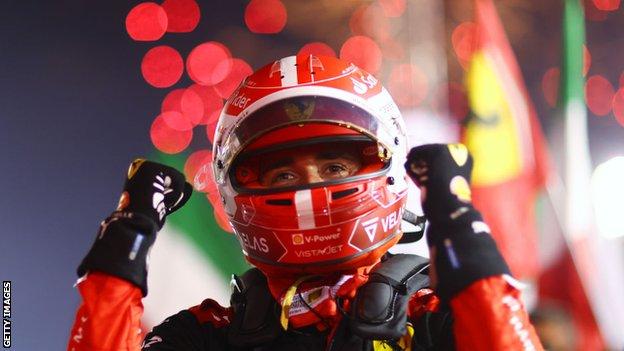
For all the focus on Ferrari’s technical advances, though, a key part of their current success is the man in the cockpit. The gamble on Leclerc’s potential in 2019 has more than paid off.
He has five poles in seven races so far this season. And he would have four wins rather than two but for an engine failure in Spain, and Ferrari managing to bungle their strategy last time out in Monaco.
Leclerc outperformed Vettel to such an extent in 2019 that Binotto had decided he would ditch the four-time champion at the end of the Covid-delayed 2020 season before it had even started.
“We knew Charles had very high potential,” Binotto says. “When we put him in our car in 2019, he proved in the first season to be very strong and talented. The way he was attacking, defending and driving proved what he could do.
“We knew he had to improve in terms of maturity, leadership and tyre management, and I think, as the seasons passed, it gave us the confidence he could do that and would become a fantastic driver.
“We had the confidence he could be a driver who can win world championships and become a very strong leader for the team.”
Binotto also has praise for his second driver, Carlos Sainz, who has had a more difficult start to 2022, making a series of errors as he tried to keep up with a team-mate who is more at home with a car that tends to have a loose rear end. Sainz, he says, is “very fast and I am pretty sure he can win championships as well”.
Can Ferrari maintain their challenge?
For all their progress, though, Ferrari are at something of a critical moment heading into this weekend’s Azerbaijan Grand Prix.
On the one hand, this season has been positive. The car is quick, Leclerc is just nine points off the championship lead, and confidence has been boosted by the fact that the first car-upgrade package introduced in Spain last month worked as intended – so fears of a repeat of 2017 and 2018 on that front have been assuaged.
But there are worrying signs, too.
After three races, Leclerc had a 46-point lead; in the past four, Verstappen and Red Bull have enjoyed a 55-point swing in their favour.
And while Verstappen has lost a total of 36 points to technical failures following his retirements from second place in Bahrain and Australia, Leclerc has shipped 45. His own error dropped him from third to sixth in Imola, followed by the Barcelona engine failure and the strategy foul-up that turned a win into a fourth place in Monaco.
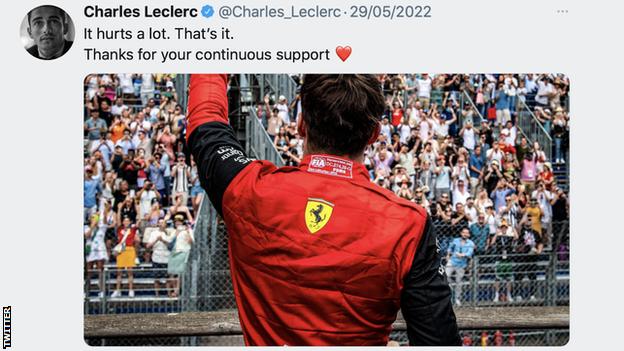
Binotto says: “We set our objectives to be back competitive in 2022. So our objective is to be competitive, not to win the championship, and it would be completely wrong to turn that into: ‘Let’s try to win the championship because we are so competitive.’
“Being competitive is one fact; becoming world champion is another level of task.
“[Saying] that is maybe to take off some pressure from the team, but also I think it would be wrong as management to change objectives from the ones we gave them.
“No doubt what we intend to do is to try to open a cycle – become world champion, and not only once; try to stay there. But I think it will take time.
“Our internal mindset is still we need to improve as a team to be capable of winning a championship.
“It doesn’t mean we will not do it. Maybe we will do it as soon as possible, but we are conscious of the fact that it is more than only being competitive.
“The ambition is there. Each single person working for Ferrari has the ambition. I don’t think I need to remind them. More important is to let them focus on our process of continuous improvement, so each race is an opportunity for lesson-learned review and to build to do something better.
“And it is important to stay focused on each single race. We are not looking at the classifications.”


